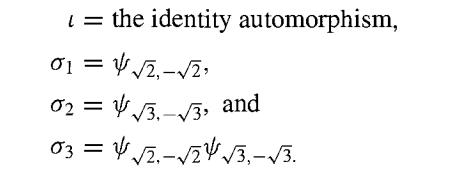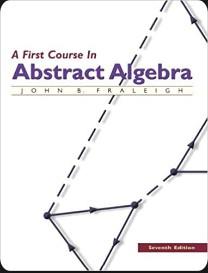Referring to Example 48.17, find the following fixed fields in E = Q(2, 3). a. E {1.3}
Question:
Referring to Example 48.17, find the following fixed fields in E = Q(√2, √3).
a. E{σ1.σ3}
b. E{σ3}
c. E{σ2.σ3}
Data from in Example 48.17
Consider the field Q(√2, √3). Example 31.9 shows that [Q(√2, √3) : Q] = 4. If we view Q(√2, √3) as (Q(√3))(√2), the conjugation isomorphism ψ√2, -√2 of Theorem 48.3 defined by ψ√2-√2(a+b√2) = a -b√2 for a, b ∈ Q(√3) is an automorphism of Q(√2, √3) having Q(√3) as fixed field. Similarly, we have the automorphism ψ√3,-√3 of Q(√2, √3) having Q(√2) as fixed field. Since the product of two automorphisms is an automorphism, we can consider ψ√2,-√2 ψ√3,-√3 which moves both √2 and √3, that is, leaves neither number fixed. Let

The group of all automorphisms of Q(√2, √3) has a fixed field, by Theorem 48.11. This fixed field must contain Q, since every automorphism of a field leaves 1 and hence the prime subfield fixed. A basis for Q(√2, √3) over Q is {1, √2, √3, √6)}. Since σ1(√2) = -√2, σ1(√6) = -√6 and σ2(√3)= -√3, we see that Q is exactly the fixed
field of {ι, σ1, σ2, σ3). It is readily checked that G = {ι, σ1, σ2, σ3} is a group under automorphism multiplication (function composition). The group table for G is given in
Table 48.18. For example,
σ1σ3 =ψ √2,-√2 (ψ √2,-√2 ψ√3.-√3)= σ2.
The group G is isomorphic to the Klein 4-group. We can show that G is the full group G(Q(√2, √3)/Q), because every automorphism τ of Q(√2, √3) maps √2 onto either √2, by Corollary 48.5. Similarly, τ maps √3 onto either ±√3. But since {1, √2, √3, √2√3} is a basis for Q(√2, √3) over Q, an automorphism of Q(√2, √√3) leaving Q fixed is determined by its values on √2 and √3. Now, ι, σ1, σ2, σ3 give all possible combinations of values on √2 and √3, and hence are all possible automorphisms of Q(√2, √3).
Step by Step Answer:






